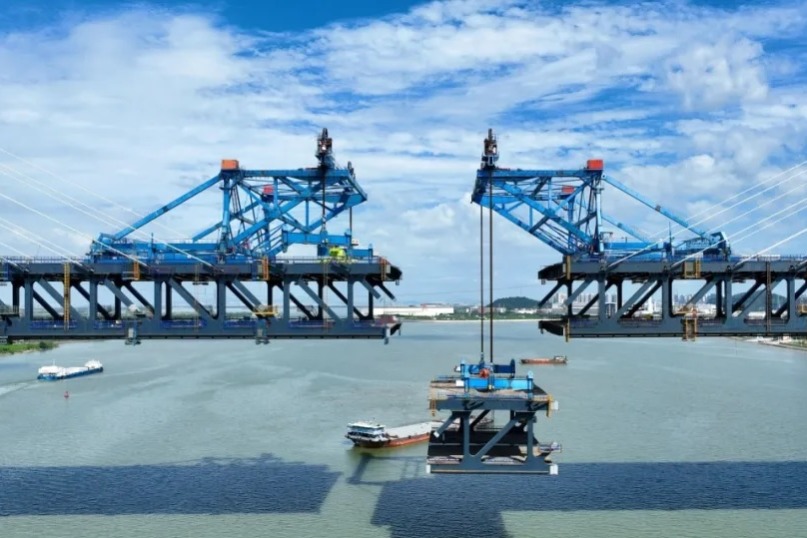Construction of a new double-decker bridge over the Pearl River Estuary is progressing at full speed in Guangdong province, with workers accelerating key milestones – a testament to China's commitment to advancing infrastructure development.
Zhang Taike, chief engineer of the project, said more than 35 percent of the Shiziyang link has been completed and the 342-meter-high main tower is expected to be completed in March.
The project, with a main span of 2,180 meters, is expected to be completed in 2028 and traffic will start flowing soon after. The Shiziyang Link, whose construction began in 2023, is another mega infrastructure project across the Pearl River Estuary and follows the Hong Kong-Zhuhai-Macau Bridge and the Shenzhen-Zhongshan Link, which were officially launched last year. Both HZMB, which opened to traffic in 2018, and Shenzhen-Zhongshan Link are megastructures consisting of bridges, tunnels and artificial islands.
As an important transport artery for the southern and western expansion of the Guangdong-Hong Kong-Macao Greater Bay Area, Shiziyang Link will be able to play a crucial role in improving comprehensive connectivity between the eastern and western city clusters on both banks of the Pearl River Estuary, Zhang said.
It will also help accelerate integrated development between the three regions of Guangdong, Hong Kong and Macao.
“After the project is completed, the travel time between Guangzhou's Nansha and Dongguan will be significantly shortened. This will not only promote closer integration between core cities in the Pearl River Delta, but also enable more efficient cross-river circulation of industrial chains, talent flow and logistics in the region,” Zhang said.
Shiziyang Link connects cities in the Greater Bay Area to major cities across the country via the region's advanced expressway network.
Previously, economic development forecasts tended to be conservative, Zhang said, adding that all overseas routes in the regions, including the Shenzhen-Zhongshan Link, Nansha, Humen and Huangpu Bridges, were operational during the National Day and Mid-Autumn Festival in the first eight days of October (all experienced heavy traffic congestion).
The Shiziyang Link, which connects Guangzhou's Nansha District and Dongguan City, is located between the Nansha Bridge (3.8 kilometers north) and the Humen Bridge (7.7 kilometers south).
Cui Bing, a national surveying and design master, said the state-of-the-art project is a world leader in the diameter of the anchor foundation (130 meters), the height of the steel plate composite tower (342 meters), the span of the double-layer suspension bridge (2,180 meters), the size of the main cable (1.5 meters in diameter) and the number of lanes (double-decker, double track, 8 lanes).
“The true value of bridge design and construction lies not in continually setting new records, but in the actual realization of structural safety and durability philosophies, as well as breakthroughs in related structural theories, construction technologies and techniques,” Cui said. He added that a bridge structural system should be established in which all components, except key support elements (such as pylons and main cables), are easily replaceable to ensure that the bridge maintains its “primary functionality” throughout its life cycle. “This philosophy has been put into practice at Shiziyang Link,” he said.
While the bridge's progress may be surpassed in the next 10 to 20 years, its design, technology, philosophy, methods and structure will influence the design and construction of bridges worldwide in the future, said Cui, chief engineer at Highway Consultants of China Communications Construction Company.
“And the design of the project follows the principles of economy, applicability, environmental sustainability, durability and multi-disaster resilience,” he added.
Meanwhile, the Lianhuashan Link connecting Guangzhou's Panyu District with Dongguan City is also planned and is expected to begin construction in the 15th Five-Year Plan period (2026-30), said Xu Jun, deputy chief engineer of CCCC Highway Consultants. The relevant authorities will soon decide whether it will be a bridge or a tunnel crossing the mouth of the Pearl River.
And the Lingdingyang connection, which connects Shenzhen and Zhuhai, is also planned to further expand relations between the two Chinese special economic zones. The Lingdingyang Link will be a dual-purpose railway and highway link.
zhengcaixiong@chinadaily.com.cn
